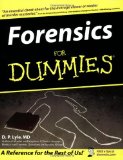The Child Cases: Guilty Until Proved Innocent-- Nearly two dozen cases in the US and CA in which people have been accused of killing children were based on flawed or biased work by forensic pathologists and later cleared. .Many morgues are staffed by doctors who aren't board-certified in forensic pathology. To become certified, doctors need an extra year of training and must pass a test. --A.C. Thompson, Joseph Shapiro, Sandra Bartlett and Chisun Lee
Blunders by doctors in America's morgues have convicted innocent people, allowed the guilty to go free and left cases so muddled that prosecutors could do nothing.
ProPublica Post Mortem --The US coroner and medical examiner offices are a dysfunctional system . An increasing number of Americans go to the grave without being examined. PBS Post Mortem -- A collaborative investigation of 2,300 US coroner and medical examiners at UC Berkeley and California Watch reveals a system that allows the guilty to walk and the innocent to be erroneously convicted
DNA Tracker: Crime Labs and Their DNA Backlog-- At least 350,000 DNA samples from murder and rape cases remain untested, according to the federal government estimates. Much of it can be traced to new federal and state laws requiring DNA samples from people convicted of or arrested for nonviolent crimes, including shoplifting. These laws are underfunded and understaffed. DNA collection laws by state.
Forensic science braces for change -- If forensics is to shake its negative image,.forensic scientists need to invest more in validation and work closely with crime labs that implement those technologies.The gap between research and its application in solving crimes is described as the "valley of death".
The National Academy of Sciences (NAS) states fingerprinting, hair fiber analysis and marks by weapons, evidence, commonly used in the courtroom,. have never been scientifically validated. Only DNA analysis has been proven to match a suspect to a crime.
What is touch DNA? The technology that cleared JonBenet Ramsey's family can detect the slightest bit of genetic material.
A Beginner's Primer on the Investigation of Forensic Evidence by Kim Kruglick "Seldom, if ever, are the forensics in a case as tight as the prosecution would want you to believe."
.Virtual Autopsy -- Read the case histories with autopsy reports.
Virtual Exhibit on Forensic Science -- An informative and fun introduction to forensic science. Explore evidence from crime scenes,. test your skills and knowledge. Canadian Heritage Information Network (CHIN), the Royal Canadian Mounted Police, Carleton University in Ottawa, the Musée de la Civilisation in Québec City, the Musée de la Police de Montréal et de I'Île Bizard, the Laboratoire de sciences judiciaires et de médecine légale in Montreal, the Vancouver Police Centennial Museum as well as the Vancouver Police Department.
Making Sense of DNA Backlogs - Myths vs. Reality -- NIJ addresses the challenge of keeping up with an increasing volume of evidence.
A Chief’s Guide to DNA--A guide to help law enforcement manage their DNA testing capabilities, as they lface an increasing demand.
Forensic animation recreates criminal acts and accidents and crimes for the courtroom. Does It Work? Should It?
Forensic facial reconstruction, forensic facial approximation, is a controversial technique that recreates a face from skeletal remains through artistry, forensics, anthropology, osteology and anatomy.
A Forensic Sculptor Brings The Faces Of The Dead Back Into Sight -- Rebecca Leung
Blood Types Tutorial -- The Human Genetics Tutorial concerning the inheritance of the ABO blood group alleles. University of Arizona
An interview with DNA forensics authority Dr. Bruce Weir, an expert witness for the prosecution of OJ Simpson.
Brain Fingerprinting -- Brain Fingerprinting test results were admitted as evidence in a US District Court in 2002. In a 2003 appeal, the Iowa Supreme Court established the admissibility of Brain Fingerprinting test evidence.
Forensic Anthropologists Aim to Identify Bodies in Cemetery Scam--Scientists--including one who studied King Tut--are working to examine hundreds of human remains illegally exhumed from a Chicago burial ground
Discovering the Secret of Life Dr. Watson's Magical Morning Dr. James Watson -- In medicine, DNA is critical in diagnostics and in the development of therapies. In the law, DNA fingerprinting plays a central role in our attempts to apprehend criminals. On the farm, biotechnology is improving the quality of the food we eat and reducing the toxic burden of pesticides on the environment. This is just the beginning:
Additional Resources:
21st Century Complete Guide to the National Institute of Justice and the US Marshals Service of the US Justice Department: Crime Scene Investigation (CSI), DNA, Forensic, and Cold Case Investigation, Homeland Security and Terrorism (Core Federal Information Series CD-ROM) by US Government This CD-ROM provides full coverage of the National Institute of Justice; US Marshals Service; Crime Scene Investigation (CSI); DNA Testing and Research; Forensic and Cold Case Investigation; Technology and Criminal Investigation; Homeland Security and Terrorism Incident Investigation, illustrated with color photography, tables, charts, and graphs. Privately-compiled collections of official public domain US government files and documents - not produced by the federal government. Over 54,000 documents allow direct viewing on Windows and Apple Macintosh systems.
Blood Evidence: How DNA is Revolutionizing the Way We Solve Crimes -- The principles and science behind DNA testing and how it has helped solve criminal cases in recent history and to discredit eyewitness accounts and physical evidence.
Kari & Associates
PO Box 6166
Olympia, WA 98507
Copyright Kari Sable 1994-2011


